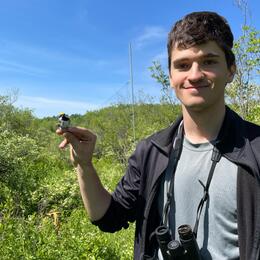If all hope is lost in the fight to safeguard biodiversity from habitat fragmentation, environmental degradation, and climate change, don’t tell Vermont’s conservation leaders.
Last month, I had the privilege of witnessing their wisdom, ambition, and, in the good-humored words of Audubon Vermont’s executive director David Mears, “irrational hope” swirl around a rustic conference room at Lareau Farm in Waitsfield. The environmental leaders had gathered there to explore the formation of a “biodiversity coalition” dedicated to accelerating the protection and restoration of Vermont’s natural world. As the event’s designated note-taker and photographer, I enjoyed a front-row seat to the proceedings. Though the coalition remains in its early stages, the fall workshop made one thing abundantly clear: Vermont’s environmental community is ready and eager to leverage its robust resources, programs, and relationships into transformative change for the future of biodiversity, both within state lines and beyond.
The idea to assemble a statewide biodiversity coalition first sprouted in August 2021, when several Vermont conservation leaders met with Doug Tallamy, the renowned ecologist and author of Nature’s Best Hope, in Montpelier’s Hubbard Park. The conclusion they reached was simple, yet powerful: high-level collaboration among Vermont’s conservation organizations can achieve more for nature than the sum of their individual efforts. These organizations, they reasoned, already offer a wealth of resources and programs to guide conservation action, especially for the private landowners who manage 80 percent of Vermont’s land. With the proper channels for collaboration, and a dash of creativity, these resources could combine to move Vermont substantially closer to a just, biodiverse future, in keeping with its status as a national leader in conservation.
At the October workshop, twenty-nine environmental advocates from a variety of organizations briefly stepped back from their on-the-ground conservation efforts to engage in critical conversation about major questions surrounding the biodiversity crisis in Vermont: What are the specific problems we need to solve? What opportunities do we see to address those problems? And, perhaps most importantly, where do we start? As the group included members from all branches of the conservation field, including ecologists, foresters, public officials, non-profit and business leaders, and community organizers and educators, there were at least as many answers to these questions as there were participants. Nevertheless, one point achieved unanimous consensus: the local, regional, and global declines in biodiversity are an urgent, existential, and multifaceted problem requiring bold, equitable, and interdisciplinary solutions. Indeed, almost 3 billion birds have vanished from North America since 1970, contributing to the belief by some scientists that we have entered a sixth mass extinction.
Many conversations centered on the need for enhanced outreach and engagement of all stakeholders in a biodiverse Vermont—in other words, all Vermonters, current and future. While crucial dialogue took place around next steps to implement landscape-level plans like the Vermont Conservation Design, these discussions did not occur independently of questions about justice, equity, diversity, and inclusion. Who currently has a seat at the conservation table? Whose voices must be better represented? And, especially as climate migrants and refugees begin to settle in Vermont, how will people fit into our biodiversity vision? The group recognized that educating landowners, communities, and youth alike about the biodiversity crisis and the need to reconsider our relationship with the natural world is a critical next step toward a just and sustainable future.
In spite of widespread agreement that solutions to the state’s biodiversity and equity problems will require immense effort, a sense of hope permeated the workshop. Just over a century ago, extensive land clearing in Vermont resulted in dramatic biodiversity loss, including local extinctions of the catamount and gray wolf and severe downturns in deer and fish populations, with grave economic and cultural repercussions. In the following decades, a decline in agricultural activity, along with the establishment of a state forestry program and an influx of private land donations, gave Vermont’s landscape and ecosystems the time and space they needed to bounce back. And under the collaborative leadership of the state’s most passionate and experienced conservationists, Vermont can bounce back again.
As an environmental policy intern new to Vermont, I entered the workshop unsure about what to expect. The biodiversity crisis, after all, is global in scope, and fueled by social, cultural, and economic norms that often seem too deep-rooted to yank free from the public consciousness—let alone by a couple dozen Vermonters in Waitsfield. But what I found—and what many of the leaders in that room have worked for decades to make true—is that there is, in fact, no better place than Vermont to secure a biodiverse future. Informed by its history, unrestrained by its imagination, and empowered by its pride, Vermont has the leadership, resources, and enthusiasm to effect transformative change and inspire others to follow suit. And when these assets work together, and all Vermonters are invited to the table? The outcome might look countless different ways, but one thing is certain: you won’t want to miss it.
Audubon Vermont and the other workshop participants are grateful for the support of the Daybreak Fund for Climate and Community Resilience and of Lareau Farm and Forest, which made the event possible.
If you are interested in learning more about the initiative or joining the biodiversity coalition, please contact David Mears (david.mears@audubon.org) or Curt Lindberg (vermontallianceforhalfearth@gmail.com).




